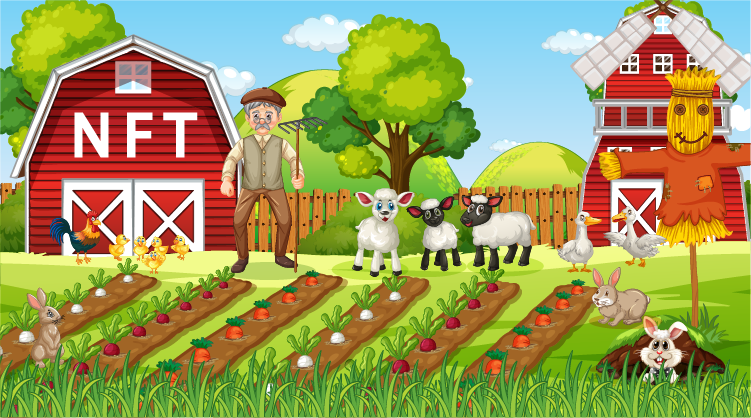If you wonder whether we will talk about farming or online farming in games, you will sadly be disappointed. NFT farming is where DeFi and NFTs come into play together.
What about NFT farming?
NFT farming involves staking NFTs for a reward or staking tokens for an NFT as a reward. It is similar to yield farming. However, it involves NFTs as either a reward or a staked token, thus creating liquidity and utility for NFTs that are otherwise illiquid digital assets.
For people familiar with yield farming from the crypto world, it will be easier to understand NFT farming as it is almost an extension of yield farming, but here NFTs earn you rewards like other NFTs or staked tokens.
NFT farming adds liquidity to the NFTs owned by the HODLers and puts their digital assets to work. It can help them get better returns and, in turn, even allow them to acquire new NFTs. So if your next question is,
“Sounds interesting; how does this work?”
Well, let’s dive straight into that. Since NFTs are also digital assets, NFT farming works very similarly to yield farming, where you need a token that needs to be put into a pool, which in turn earns you a reward as per the specified APY (Annual percentage yield).
Since NFTs exist on various blockchains (mostly Ethereum but lately also on Solana, Cardano, & more). With most modern blockchain networks adding NFT functionality to their infrastructure, they are interoperable since they follow certain standards – making it easier to connect with various applications. Interoperability simply means that different systems can connect, or in this case, one digital asset can connect with multiple programs or smart contracts.
How to get started?
To get started with NFT farming, users will need a few things
- A wallet
- A blockchain network to connect their NFTs
- A certain token in the wallet, depending on the platform chosen
This token will be staked in a pool to earn rewards based on their proportion of the total pool.
A staking portal will turn the compatible NFTs into vaults from which you can earn rewards. A growing list of staking portals would help you stake tokens to farm limited edition NFTs, which can then be sold on NFT marketplaces such as OpenSea or Rarible.
The tokens allow a user to generate rewards in the form of that particular portal’s token, which can then be used to claim the NFTs. There are several guides on how to get started with NFT farming on portals like MEME portal, which should be a good starting point before you decide to jump into this ocean of opportunities.
Other developments that gained attention
Another recent development is the gamified NFT Farming where a gaming layer is added to the DeFi & NFT mix and has gotten a lot of attention from the gamer community. Binance has a good explainer on crypto gamification, which is a must-read to understand how this ecosystem is shaping up and where it stands today.
One of the most famous games that have captured a massive fanbase is Axie Infinity, where players earn in-game SLP (Smooth Love Potions) tokens that they can then sell for money or use to create new NFTs.
The newly minted NFTs are Axies, and players can monetize these creatures in multiple formats. Players can use their Axies in battles and create more Smooth Love Potions (SLP), which are tokens with real value, or they can use their Axies for breeding more Axies.
Moreover, players can simply sell their newly created NFTs on the internal marketplace. The innovation in this sphere is simply mind-blowing and only limited to your imagination. At this stage, if you are saying to yourself, “This all sounds great. Should I know of something else?” Well, yeah, sure.
The drawbacks you need to know
There are a few cons to this wonderful-sounding stuff you have read so far. NFT Farming is a new and one-of-a-kind way of diversifying your crypto portfolio, and as such, just like almost every other phase of blockchain, it has its risks.
Its biggest strength is also its biggest weakness:- composability. Since NFT platforms are build-up blocks, different blocks could also crumble if one block acts up. Smart contract bugs are also a vital risk since most of this tech is still in its infancy. Not to mention the risk of hacks and other attacks besides the fault in operation and the results can be quite damaging.
To sum it up, NFT farming is a great new tech that is evolving rapidly and making great strides which has given additional flexibility to NFT HODLers and traders besides buying and selling their NFTs. They can convert their NFTs into liquid assets and monetize them by earning rewards. In the meantime, we can just hope that the hype and attention it is getting will surely help in maturing this into a full-fledged industry with rapid improvements.
The post What Is NFT Farming and How Does NFT Farming Work? appeared first on bitsCrunch.
